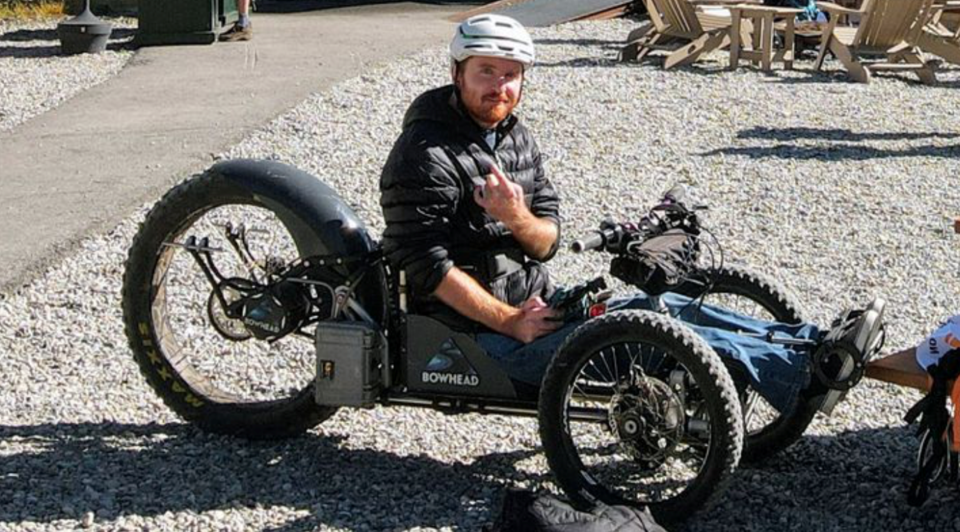In the 22 years following his first bike race at the age of 6, Longmont’s Jay Davis dedicated time each day to engage in his favorite activity of all time — cycling around Colorado’s Front Range and beyond.
“There wasn’t a day that went by where I didn’t ride a bike of some kind,” Davis said, “whether it was getting on a mountain bike in the mountains or just riding my road bike to and from work.”
For Davis, his love for cycling stems from a bike’s ability to carry him to new places in nature. He believes humans, like any other animal, “are meant to be out in the wild, enjoying the beautiful scenery and fresh air,” he said.
Davis’ adventurous attitude growing up also led him to pursue flight lessons starting at age 16. From there, he quickly obtained his commercial pilot license and spent the next 12 years borrowing and renting airplanes from others to fly up into the sky — that is, in moments when he wasn’t riding a bike exploring new mountain terrain.
In February of 2018, 28-year-old Davis was thrilled to buy his own airplane for the first time — a Thorp T-18. As is common practice when buying a new airplane, Davis began transition training with an instructor to learn the ins and outs of operating the plane which was built in the 1970s, he said.
As Davis was practicing takeoffs and landings during one of these sessions on February 16, 2018, however, one of the airplane’s controls malfunctioned, causing a tragic accident.
“On the last landing of the day, one of the control cables broke; the one you need to steer on the ground,” Davis said. “So we couldn’t steer and we ran off the runway, flipped over and landed upside down.”
In the accident, which occurred at Vance Brand Municipal Airport in Longmont, Davis dislocated two vertebrae, leaving him paralyzed from the chest down.
For the past approximately three and a half years, Davis has struggled with his mental and physical health while adapting to a new life that seems confined to his wheelchair. Mostly, he misses cycling.
“I haven’t really been able to get out and enjoy the outdoors the way I used to and that’s definitely taken its toll on me,” Davis said. “Flying was just a hobby and that’s what ended up paralyzing me, but biking was my life.”
Finding ways to get back into the mountains since his paralysis has been a challenge, as “rough, rugged terrain isn’t really friendly to wheelchairs,” he said.
Things changed for Davis when he discovered the Bowhead Ranch three-wheeled adaptive electric mountain bike created by sports and recreation business Bowhead Corporation.
“This model is hands down the closest thing I’ve found to something that actually feels like riding a bike,” Davis said about the bike model, Bowhead Reach. “The front end of it is really unique and it articulates so that you can lean into corners and actually carve corners.”
For Davis, riding Brett’s Bowhead Reach on several occasions has given him the freeing feeling of being able to go somewhere again, as well as the ability to get through rugged terrain, which is the fun part of riding bikes, he said.
When asked what it would mean to him to have his own Bowhead Reach, Davis said, “I don’t even know how to put it into words.”
To purchase sophisticated, adaptive equipment such as the Bowhead Reach, the price is high. “Anytime you slap the word adaptive onto a piece of equipment, including outdoor sports things, the price gets astronomical,” Davis said. With the adaptive options he needs, Davis expects the Bowhead Reach will cost around $17,000.
A couple of weeks ago, Davis was awarded a grant from the High Fives Foundation, a California-based nonprofit that provides resources to injured athletes and veterans so that they can be active again.
Hoping to use the grant money to purchase a Bowhead Reach but feeling crunched for time as a result of the grant’s end-of-2021 expiration date, Davis has created a Go Fund Me in efforts to raise money to supplement the rest of the bike’s cost before the end of the year.
According to Davis’s Go Fund Me, any money that’s raised past Davis’s $10,000 goal, he will donate back to the High Fives Foundation so the organization can help other injured athletes get back to the sports they love.



